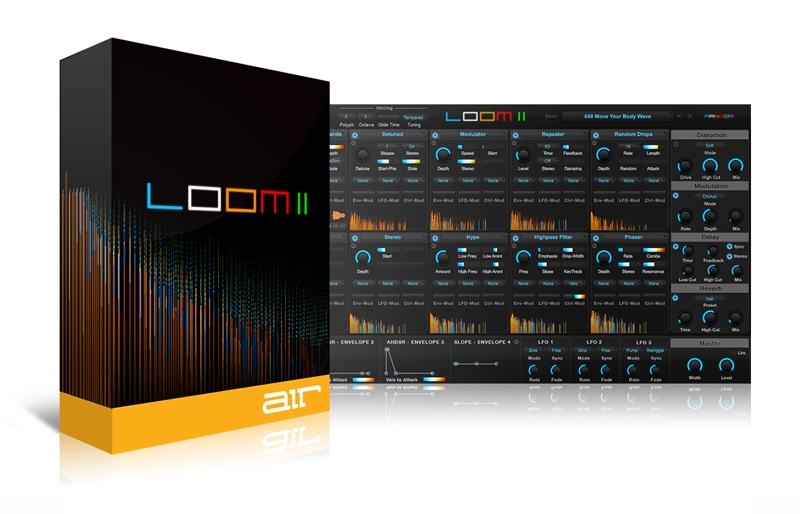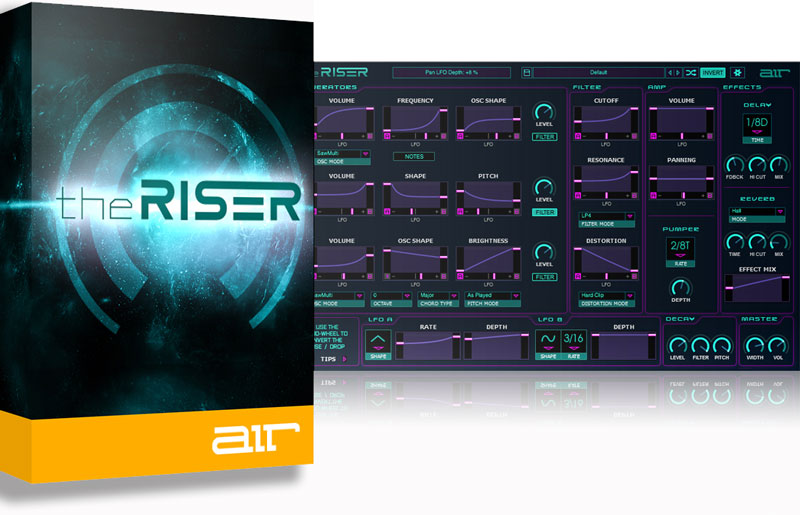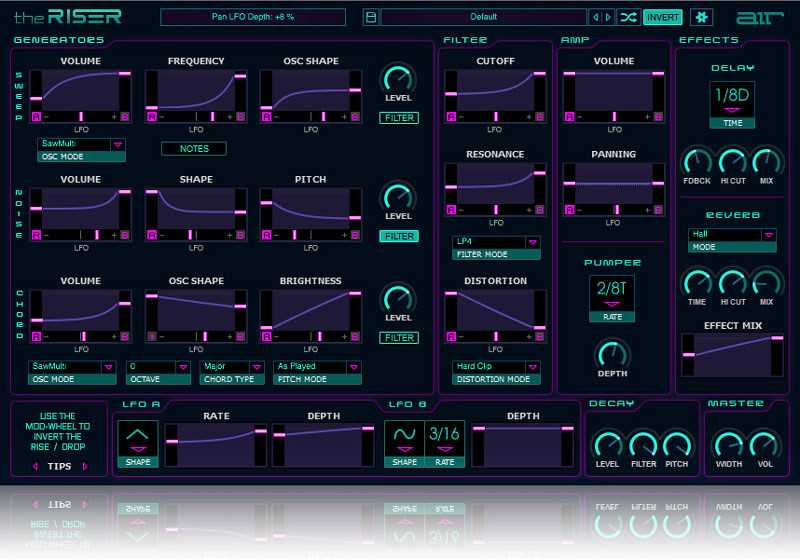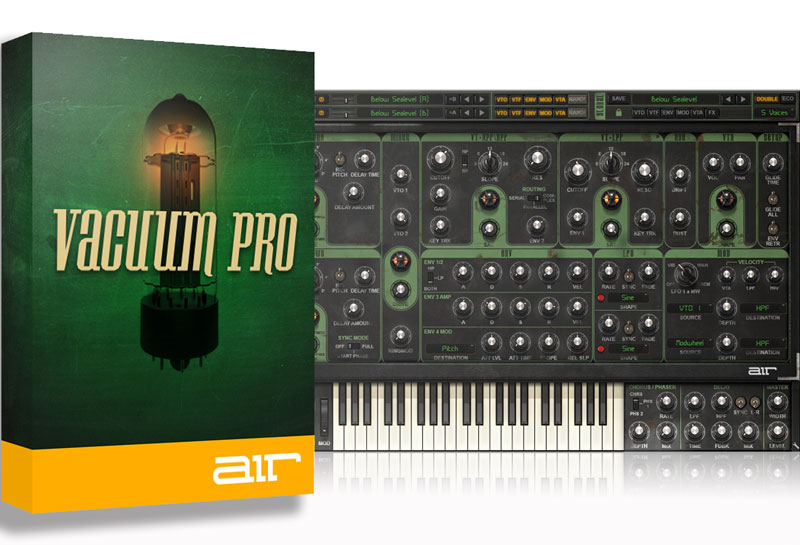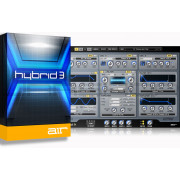You're currently on:
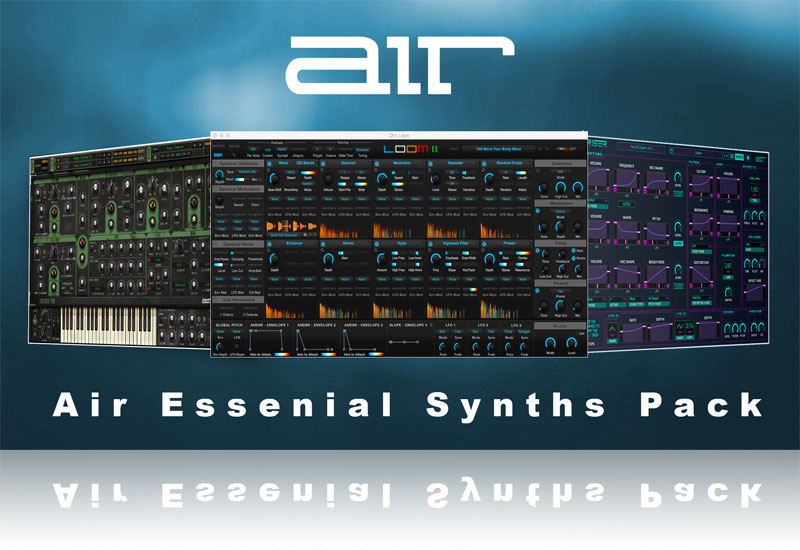
AIR Essential Synths Pack
Loom II
Explore Additive Synthesis
Loom II is a major upgrade to the original, pushing the boundaries of additive synthesis. Loom II is ideal for all skill levels. Whether you're starting out and just experimenting in this space or you're a bonafide expert, the instrument grows with you.
Loom II is an award-winning modular additive synthesizer with a shape-shifting Morph Pad that makes it easy to create rich, swirling and captivating sounds. The original Loom was considered a triumph of its time when it was launched. Now, Loom II builds on this with unique and powerful new features as requested by our loyal users.
Loom II takes a unique modular approach to additive synthesis, a synthesis technique that involves combining simple waveforms together to create complex sounds, by enabling anyone to select from and combine 34 editable modules. Create anything from wobbles, organs, ethereal pads, ambient soundscapes and so much more. The programmable Morph Pad brings your Loom II patches to life by morphing between user-defined variations of your patch, adding motion and momentum that continuously evolve.
New for LOOM II:
Loom II has been expanded to 8 voices by popular request!
Spectral Noise section allowing a secondary oscillator to replace or enrich the additive spectrum (created with the Sine Oscillator) with a noise spectrum. This is truly revolutionary in the additive world. Your creativity is the only limit to what is possible!
4 new modules (See module section)
2 additional Subharmonic Optional Partials bellow the normal spectrum.
Enhanced Morph Pad options.
500 all-new patches covering a wide range of sounds designed by acclaimed sound designers Richard Devine and Mark Ovenden.
All original 350 patches re-mastered taking advantage of the new features.
New Wave Parameter options
20+ other performance enhancements.
Mix & Match Modules
Loom II delivers up to 512 harmonic partials per patch and uses an intuitive modular design to create complex sounds quickly and easily. Each of the 34 editable modules performs a specific sonic task—Octaver, Second Tone, Moving Filter, Noise, Linear Lowpass, Modulator, etc. The Loom II framework provides a series of cells, where up to 10 of these modules can interact combine to generate an additive synthesis patch. Each module includes task-specific parameters for detailed, individual control of the patch. For real-time visual feedback of your sound, each module includes a spectrum window, offering a visual indication of how that module is affecting the individual harmonics of the sound.
In Loom II we have added four new powerful modules:
5-Sines – An easy-to-use module enabling you to produce a range of organ or sine style sounds.
Discrete Adder – Similar to Loom 1’s popular adder, but adding a discrete spectrum ideal for creating percussion-based synth instruments.
Hype – adding Hi and Low Hype with dedicated easy-to-use controls for instant results.
Double Wave – for our more advanced users: Use dual waves to create complex synth patterns. We have also added a dedicated control for this in the Morph pad.
Make Your Music Move
Loom II’s Morph Pad is a powerful tool that adds dynamics and movement to your patches. Using a condensed set of control knobs, Loom II enables you to quickly create up to four variations of your sound, and assign each one to different quadrant of the Morph Pad. Point, click, and drag anywhere on the Morph Pad to create a morph path. As the sound moves along this patch, you will hear it morph in real time between your four variations. This morphing can be free-form, or set to sync up to a particular musical unit—1 bar, 4 bars, etc. Plus, each segment of the morph path can be synced individually. In Loom II, we have expanded our highly-acclaimed morph pad by allowing Points/Paths to be stored and restored separately. We have also added a new X-Axis mode enabling it to perform like an envelope, which is ideal for rhythmical morph patterns. For this new mode Snap/Grid is also available. Additionally, for expanded creativity you can now use parameters not linked to the Morph.
Stunning Sound Design
Loom II comes packed with sounds. Acclaimed sound designers Richard Devine and Mark Ovenden have created 850+ professional, tweakable patches that include wobbles, pads, bass, soundscapes, and more. 500 all-new presets for LOOM II and 350 re-mastered presets from LOOM I. You can tweak, analyze, and customize their sounds to make them your own, or dig deep and begin creating your own additive sounds from scratch. For sonic inspiration, Loom II’s Smart Sound Randomizer instantly generates new parameters—or a new mix of modules—to jump-start your sound design sessions. All parameters can be mapped for MIDI control. Additional preset packs are available free of charge and for purchase from 3rd-party partners to provide additional creativity.
More than Modules
Each Loom II patch begins with editable Spectral Distortion and Spectral Modulation controls that influence the overall sound. Three LFOs provide tempo syncable modulation sources that any module can access. Four velocity-sensitive Envelope Generators add an extra layer of control that can change and evolve over time. Octave control, global pitch, glide time, and other patch-specific controls offer additional tools for your custom sound-shaping experience.
Expressive Effects
On-board effects add extra expression to your customized additive sound creations. Using the drive or distortion on an additive sound can produce an aggressive edge or introduce rich harmonic changes. Modulation effects include a chorus and a phaser. Each adds remarkable depth and motion to your sound. Loom II also includes a reverb effect to help your sound sit in the mix, or to create an expansive audio environment.
Loom II System Requirements:
PC: Windows 10, 8 or Windows 7 Service Pack 1; Minimum Dual Core 2GHz (Intel Core i5 or i7 Recommended)
Mac: Mac OS X 10.8.5-10.13; Core Duo Processor (Core i5 or i7 Recommended)
Minimum RAM 4GB (8GB or more recommended)
Internet Access (Download and Authorization)
iLok License Manager required for supported computer or iLok (gen 2/3) hardware key authorization.
The Riser
Stops Hearts. Tops Charts.
The Riser is an all-new instrument for designing musical transitions of epic proportions. A powerful, synth-based instrument, The Riser features all of the tools you need to compose heart-stopping transitions in one intuitive user-interface. In seconds, you can construct rises, falls, swells, fades, and more, based on our coveted sound synthesis technology. For instant inspiration, The Riser includes 300 pro-grade presets that you can edit, deconstruct, copy, mangle, and implement into your tracks.
Transitions add suspense, hype, drama, and movement to your music. Cymbal swells and reversed instruments were go-to transitions for years, until the DAW pioneered fast and flexible audio editing, paving the way for complex sound effects. When combined with synths and other audio shaping tools, transitions completed their metamorphosis from science to art. Until now, this process has convoluted and time-intensive, taking attention away from the overall project itself. The composer spent more time trying to get plugins, virtual sample players, hardware effects, sound modules, and other gear to play nice with each other – and that was before hitting “record”.
A 3-for-All
Featuring the most powerful and musical virtual synthesis available, The Riser can be used to create classic transitions or effects never-before-heard by human ears. The core of The Riser’s mojo are three continuously variable oscillators; sweep, noise and chord. Each oscillator features a dedicated Filter send and graphical parameter depiction.
Sweep – featuring volume, frequency and oscillator shape – dictates the direction and progression of the transition. Create rises, falls, stops, and swells with audible and visible feedback.
Providing volume, shape, and pitch controls, the Noise oscillator infuses texture into your transition. Start shaping to add grit, bite, hiss, punch, and more to the effect.
The Riser’s Chord oscillator introduces you to an uncharted creative continent. Use it to match The Riser’s sonic structure to your song’s key (or a contrasting one) and blend it to taste; it can be as musical as you want.
Three Low Frequency Oscillators (LFOs) provide additional modulation to your transition. A tempo-sync’d LFO works in harmony with the native song tempo in your DAW to increase the transition’s complexity. The second LFO is free-running, meaning it has not ties to the native tempo. Third, the Pumper effect modulates the synthesis with dynamics control in tandem with track tempo. This pulsating effect adds punch and movement to the transition, and features various time divisions and depth controls for adapting to or accentuating your track.
For those looking for turn-key transitions, our team of sound designers have constructed 300 fully editable presets across various types, bringing modern, useable transitions to your project.
Wide Compatibility
The Riser offers unequalled flexibility with your current production/composition setup. Available for Mac or PC and in AU, VST and AAX formats, it can operate as an instrument in nearly any DAW such as Logic Pro X, Cubase, Ableton Live, Pro Tools, Sonar, Digital Performer, Reaper and more. It does not require specialty sample players or proprietary software in order to be used in your DAW project – simply call it up when you need it, and use it. Further, you can map your favorite keyboard or controller to the virtual knobs and faders within your The Riser or most DAWs, offering seamless operation with your composition style.
Get effected
We put the essential effects for transition design into The Riser, for fast access to studio-grade audio manipulation heaven. A tempo-sync’d delay with time-division can slap or drench your transition with the subtlety of a feather – or sledgehammer. To add space to your patch, mix in one of 4 reverb types, all of which are completely adjustable to complement your track. To really grab the listener, we incorporated Panning and Width controls, letting you master stereo positioning and intimacy. The Filter section features over 20 types, ranging from low-pass, high-pass, band-pass, multi-pole/pass combos, band reject, and phase shift. When used in concert with The Riser’s LFOs and variable oscillators, you get standout results with signature flair.
Invert Your Thinking
Experimentation is the key to inspiration, and The Riser gives you a few additional tricks to unlock new sounds. A randomizer will randomly select values for the main parameters to give you that create spark. The Invert mode will reverse the transition, letting you hear it with the direction switched. Rises become falls, swells become fades, and more. Tap the Swap button and those inversions will override your current setup, making it easy to create complementary patches and save them as presets along the way.
Like You’ve Never Experienced Before
We understand the science behind the suspense and emotion that a great transition delivers. Until now, recreating the transition in your head has been a convoluted, manual process. The Riser puts intuitive sound-shaping tools right where you need them so you can design effects that keep the listener on the edge of their seat.
Features
Transition designer optimized for electronic music production, scoring, and remix work
3 editable oscillators; sweep, noise, and chord
3 LFOs; free-running, tempo-synced, and Pumper
23 filter types including multi-pole and phase shift
300 professionally designed, editable presets
Randomizer generates patches at the click of a button
Invert mode creates complementary patches by instantly changing transition direction
Easy MIDI-Learn Mode; just click and twist to assign parameters to your favorite MIDI controller hardware
Pumper effect creates pulsating movement
Configurable delay and reverb with wet/dry processing; 4 reverb types
Adjustable panning movements and master stereo width control
64-bit AU; 32- and 64-bit VST/AAX; Mac or Windows
System Requirements
VST (32 bit and 64 bit) qualified for Ableton Live, Cubase, Arsenal
AU (64 bit only) qualified for Logic Pro X
AAX qualified for ProTools 10.3 (32 bit), ProTools 11.x (64 bit)
PC: Windows 8 (64 bit), Windows 7 (64 bit); Minimum Dual Core 2GHz (Intel Core i5 or i7 Recommended)
Mac: Mac OS X 10.8.5-10.10; Core Duo Processor (Intel Core i5 or i7 Recommended)
Minimum RAM 4GB (8GB or more recommended)
Installer Download Size: 250 MB (Windows), 140 MB (Mac)
iLok account required (a physical iLok dongle is not required)
Vacuum Pro
Analog Just Got Warmer
Vacuum Pro is a polyphonic analog synthesizer with vacuum tube circuit modeling that perfectly captures the crunchy, warm sound of the analog era. With four analog oscillators, multiple filters and envelopes, and built-in audio effects, Vacuum Pro lets you dive deep into subtractive synthesis to recreate those sought-after analog sounds from the 70s and 80s. Tweak the switches, knobs, and dials to program anything from basses, leads, pads, or unique sound effects. For even more warmth, Vacuum Pro has six virtual vacuum tube circuits that add crunch and grit at every stage of the signal path. Analog just got a whole lot warmer.
Vintage Vibes
Vacuum Pro is a powerful combination of two separate synthesizer parts that can be stacked, split, and layered to produce big, wide, and fat analog sounds. Each Vacuum Pro part starts with two wide-range, vacuum tube oscillators that can be synched, detuned, and set to various octave levels. Plus, Quad Detune controls per oscillator make it easy to quickly dial in lush sounds. For an even bigger sound, the built-in Doubling effect instantly widens and thickens up your patch.
Shape your sound with two vacuum tube filters that include a traditional low-pass filter and a selectable high-pass/band-pass filter. Vacuum Pro also has four envelope generators, matrix-assignable modulation, and a tempo sync’d LFO. The mixer offers a drive circuit and a tone-warping ring modulator. For authentic analog behavior, the Age controls let you manipulate the drift of and add dust to your sounds.
Programming Powerhouse
Vacuum Pro comes complete with 350+ tweakable patches created by acclaimed sound designers Richard Devine and Mark Ovenden. You can load these patches separately into each Vacuum Pro part to combine and experiment with multi-timbral sounds. For instant sound inspiration, Vacuum Pro features Smart Sound Randomization, which randomly generates new settings for either part or both. Define which modules you want to lock at their current settings, which will be randomized, and then let Smart Sound dial in a patch for you.
Global Control
Vacuum Pro’s Smart page condenses all the individual parameter controls into eight macro knobs that enable you to quickly shape the sound of your patch without extensive tweaking. Macro knobs such as Punch, Emphasis, and Complexity add an intuitive workflow for perfecting your programming. Switch back and forth between the micro and macro modes to quickly edit or create your own custom sounds.
Extra Effects
In addition to its authentic analog sound, Vacuum Pro includes a host of creative tools that are characteristic of classic analog synthesizers. An onboard arpeggiator, which can be tempo sync’d to your DAW, offers a quick way to build melodic runs and short sequences. A built-in chorus/phaser and delay effects give life and motion to your Vacuum Pro patches. Onscreen pitch bend and modulation wheels add extra expression to any performance, and all parameters are MIDI-mappable for performance ease and automated control.
Features:
A four-oscillator polyphonic analog synthesizer with vacuum tube circuit modeling
Super-wide, fat, and organic analog sound captures the character of classic synthesizers
Two individual synthesizer parts for huge, stacked sounds
350+ tweakable patches programmed by legendary sound designers
Smart Sound Randomizer dials in settings to user-defined parameters
8 Smart Knobs for easy programming and macro control over key parameters
Economy mode reduces the load on the host processor with minimal impact on the sound
64-bit plugin: VST, AU, RTAS, and AAX formats
System Requirements:
VST (32 bit and 64 bit) qualified for:
Ableton Live, Cubase, Arsenal
AU (64 bit only) qualified for:
Logic Pro X
AAX qualified for:
ProTools 11.x (64 bit)
RTAS qualified for:
32-bit ProTools
PC: Windows 8 (64 bit), Windows 7 (64 bit); Minimum Dual Core 2GHz (Intel Core i5 or i7 Recommended)
Mac: Mac OS X 10.8.5-10.10; Core Duo Processor (Intel Core i5 or i7 Recommended)
Minimum RAM 4GB (8GB or more recommended)
1GB free hard drive space (Download and Installation)
Internet Access (Download and Authorization)
*Notes
iLok License Manager required for supported computer or iLok (gen 2/3) hardware key authorization.






















